 Indian Railways
Indian Railways (reporting mark
IR) is an Indian state-owned railway company headquartered in New Delhi, India. It is owned and operated by the Government of India through the Ministry of Railways. Indian Railways has 114,500 kilometres (71,147 mi).
of total track over a route of 65,000 kilometres (40,389 mi)
and 7,500 stations. It has the world's fourth largest railway network after those of the United States, Russia and China.
The railways carry over 30 million passengers and 2.8 million tons of freight daily.
In 2011-2012 Railway earnt Rs 104278.79 crores which consists of Rs 69675.97 crores from freight and 28645.52 crores from passengers tickets.
Indian Railways is the world's fourth largest commercial or utility employer, by number of employees, with over 1.4 million employees.
after Wal-Mart with 2.1 million employees, China National Petroleum Corporation with 1.61 million employees and State Grid Corporation of China with 1.53 million employees.
As for rolling stock, IR owns over 240,000 (freight) wagons, 60,000 coaches and 9,000 locomotives.
Railways were first introduced to India in 1853. By 1947, the year of India's independence,
there were forty-two rail systems. In 1951 the systems (many of which
were already government-owned) were nationalized as one unit, the Indian
Railways, becoming one of the largest networks in the world. IR
operates both long distance and suburban rail systems on a multi-gauge network of broad, metre and narrow gauges. It also owns locomotive and coach production facilities. The Indian railways is proposing to build the highest railway track in the world overtaking the current record of the Beijing-Lhasa Railway line.
History
Main article: History of rail transport in India

India's first train run between Mumbai and Thane

The B.B. & C.I. Railway Head Offices, 1905
The history of rail transport in India began in the mid-nineteenth
century. In 1849, there was not a single kilometer of railway line in
India. A British engineer, Robert Maitland Brereton, was responsible for the expansion of the railways from 1857 onwards. The Allahabad-Jubbulpore branch line of the East Indian Railway had been opened in June 1867. Brereton was responsible for linking this with the Great Indian Peninsula Railway, resulting in a combined network of 6,400 km (4,000 mi). Hence it became possible to travel directly from Bombay to Calcutta. This route was officially opened on 7th March 1870 and it was part of the inspiration for French writer Jules Verne's book Around the World in Eighty Days. At the opening ceremony, the Viceroy Lord Mayo concluded that
“it
was thought desirable that, if possible, at the earliest possible
moment, the whole country should be covered with a network of lines in a
uniform system”.
By 1875, about £95 million were invested by British companies in Indian guaranteed railways.
By 1880 the network had a route mileage of about 14,500 km (9,000 mi),
mostly radiating inward from the three major port cities of Bombay, Madras and Calcutta. By 1895, India had started building its own locomotives, and in 1896 sent engineers and locomotives to help build the Uganda Railways.
In 1900, the GIPR became a government owned company. The network spread to the modern day states of Assam, Rajasthan and Andhra Pradesh
and soon various independent kingdoms began to have their own rail
systems. In 1901, an early Railway Board was constituted, but the powers
were formally invested under Lord Curzon.
It served under the Department of Commerce and Industry and had a
government railway official serving as chairman, and a railway manager
from England and an agent of one of the company railways as the other
two members. For the first time in its history, the Railways began to
make a profit.
In 1907 almost all the rail companies were taken over by the
government. The following year, the first electric locomotive made its
appearance. With the arrival of World War I,
the railways were used to meet the needs of the British outside India.
With the end of the war, the railways were in a state of disrepair and
collapse.
In 1920, with the network having expanded to 61,220 km, a need for
central management was mooted by Sir William Acworth. Based on the East
India Railway Committee chaired by Acworth, the government took over the
management of the Railways and detached the finances of the Railways
from other governmental revenues.
The period between 1920 to 1929 was a period of economic boom, there
were 41,000 miles of railway line serving every district in the country.
At that point of time, the railways represented a capital value of some
687 millions sterling, and they carried over 620 millions of passengers
and approximately 90 million tons of goods each year.
Following the Great Depression, the company suffered economically for the next eight years. The Second World War severely crippled the railways. Trains were diverted to the Middle East
and the railways workshops were converted to ammunitions workshops. By
1946 all rail systems had been taken over by the government.
Organizational structure
Main article: Indian Railway organisational structure
Railway zones

Indian Railways headquarters in Delhi

CR's headquarters Chhatrapati Shivaji Terminus

NR's headquarters New Delhi Railway Station

Southern Railway headquarters, Chennai
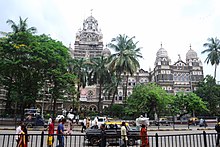
Western Railway HQ, Mumbai
Indian Railways is divided into several zones, which are further sub-divided into divisions.
The number of zones in Indian Railways increased from six to eight in
1951, nine in 1952 to sixteen in 2003 then to seventeen in 2010.
Each zonal railway is made up of a certain number of divisions, each
having a divisional headquarters. There are a total of sixty-eight
divisions.
Each of the seventeen zones is headed by a General Manager (GM) who
reports directly to the Railway Board. The zones are further divided
into divisions under the control of Divisional Railway Managers (DRM).
The divisional officers of engineering, mechanical, electrical, signal
and telecommunication, accounts, personnel, operating, commercial and
safety branches report to the respective Divisional Manager and are in
charge of operation and maintenance of assets. Further down the
hierarchy tree are the Station Masters who control individual stations
and the train movement through the track territory under their stations'
administration.
| 1. |
Central |
CR |
1951-11-05 |
3905 |
Mumbai |
Mumbai, Bhusawal, Pune, Solapur, Nagpur |
| 2. |
East Central |
ECR |
2002-10-01 |
3628 |
Hajipur |
Danapur, Dhanbad, Mughalsarai, Samastipur, Sonpur |
| 3. |
East Coast |
ECoR |
2003-04-01 |
2572 |
Bhubaneswar |
Khurda Road, Sambalpur, Visakhapatnam |
| 4. |
Eastern |
ER |
1952-04 |
2414 |
Kolkata |
Howrah, Sealdah, Asansol, Malda |
| 5. |
North Central |
NCR |
2003-04-01 |
3151 |
Allahabad |
Allahabad, Agra, Jhansi |
| 6. |
North Eastern |
NER |
1952 |
3667 |
Gorakhpur |
Izzatnagar, Lucknow, Varanasi |
| 7. |
North Western |
NWR |
2002-10-01 |
5459 |
Jaipur |
Jaipur, Ajmer, Bikaner, Jodhpur |
| 8. |
Northeast Frontier |
NFR |
1958-01-15 |
3907 |
Guwahati |
Alipurduar, Katihar, Rangia, Lumding, Tinsukia |
| 9. |
Northern |
NR |
1952-04-14 |
6968 |
Delhi |
Delhi, Ambala, Firozpur, Lucknow, Moradabad |
| 10. |
South Central |
SCR |
1966-10-02 |
5803 |
Secunderabad |
Secunderabad, Hyderabad, Guntakal, Guntur, Nanded, Vijayawada |
| 11. |
South East Central |
SECR |
2003-04-01 |
2447 |
Bilaspur |
Bilaspur, Raipur, Nagpur |
| 12. |
South Eastern |
SER |
1955 |
2631 |
Kolkata |
Adra, Chakradharpur, Kharagpur, Ranchi |
| 13. |
South Western |
SWR |
2003-04-01 |
3177 |
Hubli |
Hubli, Bangalore, Mysore |
| 14. |
Southern |
SR |
1951-04-14 |
5098 |
Chennai |
Chennai, Trichy, Madurai, Palakkad, Salem, Trivandrum (Thiruvananthapuram) |
| 15. |
West Central |
WCR |
2003-04-01 |
2965 |
Jabalpur |
Jabalpur, Bhopal, Kota |
| 16. |
Western |
WR |
1951-11-05 |
6182 |
Mumbai |
Mumbai Central, Ratlam, Ahmedabad, Rajkot, Bhavnagar, Vadodara |
Recruitment and training
Main article: Centralised Training Institutes of the Indian Railways
Staff are classified into gazetted (Group 'A' and 'B') and non-gazetted (Group 'C' and 'D') employees.
[16] The recruitment of Group 'A' gazetted employees is carried out by the Union Public Service Commission through exams conducted by it.
[17]
The recruitment to Group 'C' and 'D' employees on the Indian Railways
is done through 19 Railway Recruitment Boards which are controlled by
the Railway Recruitment Control Board (RRCB).
[18] The training of all cadres
is entrusted and shared between six centralized training institutes.
These are following list of Group A services which are recruited by the
UPSC(Union Public Service Commission ) of India
UPSC Civil Services Exam
1) Indian Railway Traffic Service, Group ‘A’.
2) Indian Railway Accounts Service, Group 'A'.
3) Indian Railway Personnel Service, Group ‘A’.
4) Railway Protection Force, Group ‘A’
UPSC Engineering Services Exam
1) Indian Railway Service of Engineers, Group ‘A’
2) Indian Railway Stores Service, Group ‘A’
3) Indian Railway Service of Mechanical Engineers, Group ‘A’
4) Indian Railway Service of Electrical Engineers, Group ‘A’
5) Indian Railway Service of Signal Engineers, Group ‘A’
UPSC Special Class Railway Apprentice Examination for recruitment to the Indian Railway Service of Mechanical Engineers
Production units
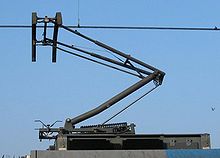
A modern pantograph. The device shown is technically a half-pantograph.

CLW made WAP-5 30022(CLW made WAP-5 locos don't have fluted body shell) rests at Bhopal

WDP4 Diesel Locomotive
Baaz which is now at New Jalpaiguri
Indian Railways manufactures much of its rolling stock
and heavy engineering components at its six manufacturing plants,
called Production Units, which are managed directly by the Ministry.
Popular rolling stock builders such as CLW and DLW for electric and diesel locomotives; ICF and RCF
for passenger coaches are Production Units of Indian Railways. Over the
years, Indian Railways has not only achieved self-sufficiency in
production of rolling stock in the country but also exported rolling
stock to other countries. Each of these six production units is headed
by a General Manager, who also reports directly to the Railway Board.
The six Production Units are:-
| 1. |
Golden Rock Locomotive Workshops |
GOC |
1928 |
Trichy |
Diesel-electric Locomotives |
| 2. |
Chittaranjan Locomotive Works |
CLW |
1947 |
Chittaranjan , Asansol |
Electric Locomotives |
| 3. |
Diesel Locomotive Works |
DLW |
1961 |
Varanasi |
Diesel Locomotives |
| 4. |
Diesel-Loco Modernisation Works |
DMW |
1981 |
Patiala |
Diesel-electric Locomotives |
| 5. |
Integral Coach Factory |
ICF |
1952 |
Chennai |
Passenger coaches |
| 6. |
Rail Coach Factory |
RCF |
1986 |
Kapurthala |
Passenger coaches |
| 7. |
Rail Wheel Factory |
RWF |
1984 |
Bangalore |
Railway wheels and axles |
| 8. |
Rail Wheel Factory |
RWF |
2011 |
Chhapra |
Railway wheels and axles |
Other subsidiaries
There also exist independent organizations under the control of the Railway Board for electrification, modernization, research and design and training of officers, each of which is headed by an officer of the rank of General Manager. A number of Public Sector Undertakings, which perform railway-related functions ranging from consultancy to ticketing, are also under the administrative control of the Ministry of railways.
There are eleven public undertakings under the administrative control of the Ministry of Railways,
[19] viz.
- Rail India Technical and Economic Services Limited (RITES);
- Indian Railway Construction (IRCON) International Limited;
- Indian Railway Finance Corporation Limited (IRFC);
- Container Corporation of India Limited (CONCOR);
- Konkan Railway Corporation Limited (KRCL).
- Indian Railway Catering and Tourism Corporation Limited (IRCTC);
- Railtel Corporation of India Limited (Rail Tel);
- Mumbai Rail Vikas Nigam Limited (MRVNL);
- Rail Vikas Nigam Limited (RVNL); and
- Dedicated Freight Corridor Corporation of India Limited (DFCCIL); and
- Bharat Wagon and Engineering Co. Ltd. (BWEL).
The Centre for Railway Information Systems (CRIS) was set up as a registered society to design and implement various railway computerization projects.
Locomotives
Main article: Locomotives in India

Two steam engines at water refilling station at Agra station
Locomotives in India consist of electric and diesel locomotives. Steam locomotives are no longer used, except in heritage trains. Locomotives are also called
locos or
engines. In India, locomotives are classified according to their track gauge,
motive power, the work they are suited for and their power or model
number. The class name includes this information about the locomotive.
It comprises 4 or 5 letters. The first letter denotes the track gauge.
The second letter denotes their motive power (Diesel or Electric) and
the third letter denotes the kind of traffic for which they are suited
(goods, passenger, mixed or shunting). The fourth letter used to denote
locomotives' chronological model number. However, from 2002 a new
classification scheme has been adopted. Under this system, for
newer diesel locomotives, the fourth letter will denote their horsepower
range. Electric locomotives don't come under this scheme and even all
diesel locos are not covered. For them this letter denotes their model
number as usual.
A locomotive may sometimes have a fifth letter in its name which
generally denotes a technical variant or subclass or subtype. This fifth
letter indicates some smaller variation in the basic model or series,
perhaps different motors, or a different manufacturer. With the new
scheme for classifying diesel locomotives (as mentioned above) the fifth
item is a letter that further refines the horsepower indication in
100 hp increments: 'A' for 100 hp, 'B' for 200 hp, 'C' for 300 hp, etc.
So in this scheme, a WDM-3A refers to a 3100 hp loco, while a WDM-3F
would be a 3600 hp loco.
Note: This classification system does not apply to steam locomotives in India as they have become non-functional now. They retained their original class names such as M class or WP class.
Technical details
Track and gauge
Indian railways uses four gauges, the
1,676 mm (5 ft 6 in) broad gauge which is wider than the
1,435 mm (4 ft 8 1⁄2 in) standard gauge; the
1,000 mm (3 ft 3 3⁄8 in) metre gauge; and two narrow gauges,
762 mm (2 ft 6 in) and
610 mm (2 ft) . Track sections are rated for speeds ranging from 75 to 160 km/h (47 to 99 mph).
The total length of track used by Indian Railways was about 114,000
km (71,000 mi) while the total route length of the network was 64,215 km
(39,901 mi) on 31 March 2011.
[20] About 33% of the route-kilometer and 44% of the total track kilometer was electrified on 31 March 2011.
[20]
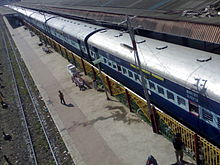
Broad gauge is the predominant gauge used by Indian Railways.
Broad gauge is the predominant gauge used by Indian Railways. Indian broad gauge—
1,676 mm (5 ft 6 in)—is
the most widely used gauge in India with 102,000 km (63,000 mi) of
track length (90% of entire track length of all the gauges) and
54,600 km of route-kilometer (85% of entire route-kilometer of all the
gauges) on 31 March 2011.
In some regions with less traffic, the meter gauge (
1,000 mm/3 ft 3 3⁄8 in) is common, although the Unigauge project is in progress to convert
all tracks to broad gauge. The metre gauge had about 9,000 km
(5,600 mi) of track length (7.9% of entire track length of all the
gauges) and 7,500 km of route-kilometer (11.6% of entire route-kilometer
of all the gauges) on 31 March 2011.
The Narrow gauges are present on a few routes, lying in hilly
terrains and in some erstwhile private railways (on cost
considerations), which are usually difficult to convert to broad gauge.
Narrow gauges had a total of 2,400 route-kilometre on 31 March 2011. The
Kalka-Shimla Railway, the Kangra Valley Railway and the Darjeeling Himalayan Railway are three notable hill lines that use narrow gauge, but the Nilgiri Mountain Railway is a metre gauge track.
[21] These four rail lines will not be converted under the Unigauge project.
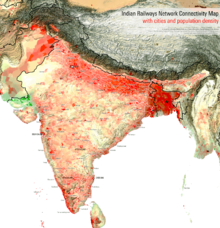
The Indian Railways serves every major populated region in the country
The share of broad gauge in the total route-kilometer has been
steadily rising, increasing from 47% (25,258 route-km) in 1951 to 85% in
2011 whereas the share of meter gauge has declined from 45% (24,185
route-km) to less than 12% in the same period and the share of narrow
gauges has decreased from 8% to 3%. However, the total route-kilometer
has increased by only 18% (by just 10,000 km from 53,596 route-km in
1951) in the last sixty years. This compares very poorly with Chinese
railways, which increased from about 27,000 route-km at the end of
second world war to about 100,000 route-km in 2011, an increase of more
than threefold. More than 28,000 route-km (34% of the total route-km) of
Chinese railway is electrified compared to only about 21,000 route-km
of Indian railways.
Double-decker
AC trains have been introduced in India. The first double decker train
was Flying Rani introduced in 2005 while the first double-decker AC
train in the Indian Railways was introduced in November 2010, running
between the Dhanbad and Howrah stations having 10 coaches and 2 power cars.
[22]
Sleepers (ties) are made up of prestressed concrete, or steel or cast iron posts, though teak
sleepers are still in use on a few older lines. The prestressed
concrete sleeper is in wide use today. Metal sleepers were extensively
used before the advent of concrete sleepers. Indian Railways divides the
country into four zones on the basis of the range of track temperature.
The greatest temperature variations occur in Rajasthan.
Electrification
As of 31 March 2011, 21,014 km of the total 64,215 km route length is electrified (33%).
[23] Since 1960, almost all electrified sections on IR use 25,000 V AC traction through overhead catenary delivery. A major exception is the entire Mumbai section, which uses 1,500 V DC,
[25] but is currently undergoing change to the 25,000 V AC system. Another exception is the Kolkata Metro, which uses 750 V DC delivered through a third rail.
Traction voltages are changed at two places close to Mumbai. Central Railway trains passing through Kasara and Karjat switch from AC to DC using a neutral section near Kalyan. Western Railway trains switch power on the fly, in a section near Dahisar, where the train continues with its own momentum for about 30 m through a non-electrified section of catenary called a
dead zone.
[25]
All electric engines and EMUs operating in this section are the
necessary AC/DC dual system type (classified "WCAM" by IndianRailways).
Railway links to adjacent countries
See also: Rail transport in India#International links
Existing rail links:
 Nepal – Break-of-gauge – Gauge conversion under uni-gauge project
Nepal – Break-of-gauge – Gauge conversion under uni-gauge project Pakistan – same Broad Gauge. Thar Express to Karachi and the more famous Samjhauta Express international train from Lahore, Pakistan to Amritsar (Attari).
Pakistan – same Broad Gauge. Thar Express to Karachi and the more famous Samjhauta Express international train from Lahore, Pakistan to Amritsar (Attari). Bangladesh – Same Broad Gauge. The Maitri Express between Dhaka and Kolkata started in April 2008 using the Gede-Darsana route, in addition to a Freight Train service from Singhabad and Petrapole in India to Rohanpur and Benapole in Bangladesh A second passenger link between Agartala, India and Akhaura Upazila, Bangladesh was approved by the Government of India in September 2011.[26]
Bangladesh – Same Broad Gauge. The Maitri Express between Dhaka and Kolkata started in April 2008 using the Gede-Darsana route, in addition to a Freight Train service from Singhabad and Petrapole in India to Rohanpur and Benapole in Bangladesh A second passenger link between Agartala, India and Akhaura Upazila, Bangladesh was approved by the Government of India in September 2011.[26]
Under construction / Proposed links:
 Bhutan – railways under construction – Same gauge
Bhutan – railways under construction – Same gauge Myanmar – Manipur to Myanmar (under construction)
Myanmar – Manipur to Myanmar (under construction) China
– Indian Railways and rail authorities in People's Republic of China
are interested in starting a high-speed rail link that would link New
Delhi with Kunming, China via Myanmar.The rail link would utilize the under construction railway from
Manipur, India to Myanmar and the under construction railway from
Kunming to Myanmar.
China
– Indian Railways and rail authorities in People's Republic of China
are interested in starting a high-speed rail link that would link New
Delhi with Kunming, China via Myanmar.The rail link would utilize the under construction railway from
Manipur, India to Myanmar and the under construction railway from
Kunming to Myanmar. Vietnam – On 9 April 2010, Former Union Minister of India, Shashi Tharoor announced that the central government is considering a rail link from Manipur to Vietnam via Myanmar.
Vietnam – On 9 April 2010, Former Union Minister of India, Shashi Tharoor announced that the central government is considering a rail link from Manipur to Vietnam via Myanmar. Thailand - possible if Burma Railway is rebuilt.[29] Would also allow trains to
Thailand - possible if Burma Railway is rebuilt.[29] Would also allow trains to  Malaysia and
Malaysia and  Singapore.
Singapore.
Types of passenger services

Delhi Duronto Express, as it rolls out of Sealdah with a Ghaziabad WAP 7 in Duronto livery

Seen here is the coaches of the Shatabdi Express, a medium-distance high-speed train connecting the four metros with the important destinations in the region.
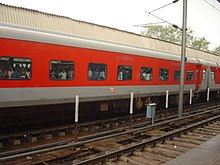
Seen here is the Rajdhani Express, which is a long-distance high-speed train connecting major state capitals with New Delhi.
Trains are classified by their average speed.
[30] A faster train has fewer stops ("halts") than a slower one and usually caters to long-distance travel.
| Rank |
Train |
Description |
| 1 |
Duronto Express |
These are the non-stop point to point rail services
(except for operational stops) introduced for the first time in 2009 .
These trains connect the metros and major state capitals of India and
are faster than Rajdhani Express.These trains are now of the Highest
Priority to the Indian Railways. The Duronto services consists of
classes of accommodation namely first AC, two-tier AC, three-tier AC, AC
3 Tier Economy, Sleeper Class, General Class. |
| 2 |
Rajdhani Express |
These are all air-conditioned trains linking major
cities to New Delhi. The Rajdhanis have high priority and are one of the
fastest trains in India, travelling at about 130 km/h (82 mph). There
are only a few stops on a Rajdhani route. |
| 3 |
Shatabdi Express |
The Shatabdi trains are AC intercity seater-type trains for travel during day. |
| 4 |
Garib Rath |
Fully air conditioned trains, designed for those who
cannot afford to travel in the expensive Shatabti and Rajdhani Express.
Garib Rath means "Chariot of the Poor". The maximum speed is 130 km/h. |
| 5 |
Jan Shatabdi |
Jan Shatabdi Express are a more affordable variety of
the Shatabdi Express, which has both AC and non-AC classes. The maximum
speed is 130 km/h. |
| 6 |
Sampark Kranti Express |
Sampark Kranti Express trains are a series of trains
that provide quick connectivity from a particular state to the national
capital, New Delhi. |
| 7 |
Superfast Express/Mail |
These are trains that have an average speed greater
than 55 km/h (34 mph). Tickets for these trains have an additional
super-fast surcharge. |
| 8 |
Express |
These are the most common kind of trains in India. They
have more stops than their super-fast counterparts, but they stop only
at relatively important intermediate stations. |
| 9 |
Passenger and Fast Passenger |
These are slow trains that stop at most stations along
the route and are the cheapest trains. The trains generally have
unreserved seating accommodation but some night trains have sleeper,
First Class and 3A compartments. |
| 10 |
Suburban trains |
These trains operate in urban areas, usually stop at all stations and have unreserved seating accommodation. |
| 11 |
Metros and Monorails |
These trains are designed for city transport in metro cities of India. |
Accommodation classes
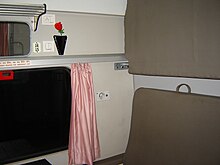
Interior of a First Class(1A) compartment in the Rajdhani Express.

Air-conditioned Chair Car(CC) coaches in an Shatabdi Express.

Interior of an air-conditioned Chair Car coach(CC) in an Jan Shatabdi Express.
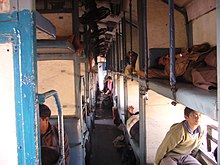
A typical sleeper class coach
Several long trains are composed of two to three classes of travel,
such as a 1st and 2nd classes which have different pricing systems for
various amenities. The 1st Class refers to coaches with separate cabins,
coaches can be air-conditioned or non air-conditioned.
Further, other AC classes can have 2 or 3 tier berths, with higher
prices for the former, 3-tier non-AC coaches or 2nd class seating
coaches, which are popular among passengers going on shorter journeys.
In air-conditioned sleeper classes passengers are provided with
sheets, pillows and blankets. Meals and refreshments are provided, to
all the passengers of reserved classes, either through the on-board
pantry service or through special catering arrangements in trains
without pantry car. Unreserved coach passengers have options of
purchasing from licensed vendors either on board or on the platform of
intermediate stops.
The amenities depend on the popularity and length of the route.
Lavatories are communal and feature both the Indian style as well as the
Western style.
The following table lists the classes in operation. Not all classes may be attached to a rake though.
| Class[31] |
Description[31][32] |
| 1A |
The First class AC: This is the most expensive
class, where the fares are on par with airlines. There are eight cabins
(including two coupes) in the full AC First Class coach and three cabins
(including one coupe) in the half AC First Class coach. The coach has
an attendant, to help the passengers. Bedding is included with the fare
in IR. This air conditioned coach is present only on popular routes
between metropolitan cities and can carry 18 passengers (full coach) or 10 passengers
(half coach). The sleeper berths are extremely wide and spacious. The
coaches are carpeted, have sleeping accommodation and have privacy
features like personal coupes. Passengers are served exclusive pantry
cooked food (included in the fare in Rajdhani Express trains only). This
class is available on broad gauge and metre gauge trains. |
| 2A |
AC-Two tier: Madarchod These air-conditioned
coaches have sleeping berths across eight partitions (with curtains).
Each partition has either four or two berths. Berths are usually
arranged in two tiers in bays of six, four across the width of the coach
then the gangway then two berths longways, with curtains provided to
give some privacy from those walking up and down. Bedding is included
with the fare. Passengers are served food. A broad gauge coach can carry
48 passengers (full coach) or 20 passengers (half coach). This class is
available on broad gauge and metre gauge trains. |
| FC |
First class: Same as 1AC, without the air
conditioning. No bedding is available in this class. The berths are wide
and spacious. There is a coach attendant to help the passengers. This
class is not very common. This class is available on all gauges. |
| 3A |
AC three tier: Air conditioned coaches with 64
sleeping berths. Berths are usually arranged as in 2AC but with three
tiers across the width and two longways as before giving eight bays of
eight. They are slightly less well-appointed, usually no reading lights
or curtained off gangways. Bedding is included with fare. It carries 64
passengers in broad gauge. This class is available only on broad gauge. |
| 3E |
AC three tier (Economy): Air conditioned coaches
with sleeping berths, present in Garib Rath Trains. Berths are usually
arranged as in 3AC but with three tiers across the width and three
longways. They are slightly less well-appointed, usually no reading
lights or curtained off gangways. Bedding is not included with fare. |
| CC |
AC chair car: An air-conditioned seater coach with a total of five seats in a row used for day travel between cities. |
| EC |
Executive class chair car: An air-conditioned
coach with large spacious seats and legroom. It has a total of four
seats in a row used for day travel between cities. This class of travel
is only available on Shatabdi Express trains. |
| SL |
Sleeper class: The sleeper class is the most
common coach on IR, and usually ten or more coaches could be attached.
These are regular sleeping coaches with three berths vertically stacked.
In broad gauge, it carries 72 passengers per coach. Railways have
modified certain Sleeper Coaches on popular trains to accommodate 81
passengers in place of regular 72 passengers. This has met with
criticism from the travellers and are now being reverted to 72 sleepers. |
| 2S |
Seater class: same as AC Chair car, but with bench style seats and without the air-conditioning. |
| UR |
Unreserved: The cheapest accommodation, the
seats usually made up of pressed wood, but the cushioned seats have been
rapidly replaced. Although entry into the compartment is guaranteed, a
sitting seat is not guaranteed. Tickets are issued in advace for a
minimum journey of more than 24 hours. Tickets issued are valid on any
train on the same route if boarded within 24 hours of buying the ticket.
These coaches are usually very crowded. |
At the rear of the train is a special compartment known as the guard's cabin. It is fitted with a transceiver
and is where the guard usually gives the all clear signal before the
train departs. A standard passenger rake generally has four general
compartments, two at the front and two behind, of which one is
exclusively for ladies. The exact number varies according to the demand
and the route. A luggage compartment can also exist at the front or the
back. In some trains a separate mail compartment is present. In
long-distance trains a pantry car is usually included in the centre.
Train numbering
Effective 20 December 2010, the railways will deploy a 5 digit
numbering system instead of the 4 digit system. The need is due to the
fact that the Indian Railways runs 10,000 trains daily.
[33]
Only a prefix of the digit 1 will be added to the four-digit numbers of
the existing trains to make the transition smoother. The special trains
run to clear festivals and holiday rush shall have the prefix of 0
(zero)
Notable trains and achievements

A Beyer Garratt 6594 Engine seen at the National Rail Museum

A tight loop (Agony Point) on the Darjeeling Himalayan Railway in West Bengal.
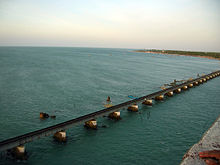
A view of the Pamban Railway Bridge, which links Rameshwaram to the mainland.Thousands of pilgrims cross the sea every day to visit the island.
There are two UNESCO World Heritage Sites on IR – the Chatrapati Shivaji Terminus
[34] and the Mountain Railways of India. The latter is not contiguous, but actually consists of three separate railway lines located in different parts of India:
[35]
- The Darjeeling Himalayan Railway, a narrow gauge railway in West Bengal.
- The Nilgiri Mountain Railway, a metre gauge railway in the Nilgiri Hills in Tamil Nadu
- The Kalka-Shimla Railway, a narrow gauge railway in the Shivalik mountains in Himachal Pradesh. In 2003 the railway was featured in the Guinness Book of World Records for offering the steepest rise in altitude in the space of 96 kilometre.[36]
- The Maharaja Railways (Gwalior Light Railway), a narrow gauge line of just 0.6m width from Gwalior to Sheopur of 198 km. in length is world's longest narrow gauge railway line is in the UNESCO world heritage tentative list.
- The Neral-Matheran Railway, a narrow gauge railway connecting Matheran is also a historic line.
- The Palace on Wheels
is a specially designed train, frequently hauled by a steam locomotive,
for promoting tourism in Rajasthan. On the same lines, the Maharashtra
government introduced the Deccan Odyssey covering various tourist destinations in Maharashtra and Goa, and was followed by the Government of Karnataka which introduced the Golden Chariot train connecting popular tourist destinations in Karnataka and Goa. However, neither of them has been able to enjoy the popular success of the Palace on Wheels.
- The Samjhauta Express
is a train that runs between India and Pakistan. However, hostilities
between the two nations in 2001 saw the line being closed. It was
reopened when the hostilities subsided in 2004. Another train connecting
Khokhrapar (Pakistan) and Munabao (India) is the Thar Express that restarted operations on 18 February 2006; it was earlier closed down after the 1965 Indo-Pak war.
- The Lifeline Express
is a special train popularly known as the "Hospital-on-Wheels" which
provides healthcare to the rural areas. This train has a carriage that
serves as an operating room, a second one which serves as a storeroom
and an additional two that serve as a patient ward. The train travels
around the country, staying at a location for about two months before
moving elsewhere.
- Among the famous locomotives, the Fairy Queen is the oldest operating locomotive in the world today, though it is operated only for specials between Delhi and Alwar. John Bull, a locomotive older than Fairy Queen, operated in 1981 commemorating its 150th anniversary. Kharagpur
railway station also has the distinction of being the world's longest
railway platform at 1,072 m (3,517 ft). The Ghum station along the
Darjeeling Toy Train route is the second highest railway station in the world to be reached by a steam locomotive.[37] The Mumbai–Pune Deccan Queen has the oldest running dining car in IR.
- The Vivek Express, between Dibrugarh and Kanyakumari,
has the longest run in terms of distance and time on Indian Railways
network. It covers 4,286 km (2,663 mi) in about 82 hours and 30 minutes.
- The Himsagar Express, between Kanyakumari and Jammu Tawi,
has the second longest run in terms of distance and time on Indian
Railways network. It covers 3,715 km (2,308 mi) in about 69 hours and 30
minutes. The Bhopal Shatabdi Express is the fastest train in India today having a maximum speed of 150 km/h (93 mph) on the Faridabad–Agra section. The fastest speed attained by any train is 184 km/h (114 mph) in 2000 during test runs.
- The third longest train in terms of distance on Indian Railways
network is navyug express between jammu tawi to mangalore covering a
distance of 3609 k.m
- Trivandrum Rajdhani is the longest non stop train in on Indian Railways network covering 528 km
 Underwater is a term describing the realm below the surface of water where the water exists in a natural feature (called a body of water) such as an ocean, sea, lake, pond, or river. Three quarters of the planet Earth are covered by water. A majority of the planet's solid surface is abyssal plain, at depths between 4,000 and 5,500 metres (13,000 and 18,000 ft) below the surface of the oceans. The solid surface location on the planet closest to the center of the orb is the Challenger Deep, located in the Mariana Trench at a depth of 10,924 m (35,838 ft) under the sea.
Underwater is a term describing the realm below the surface of water where the water exists in a natural feature (called a body of water) such as an ocean, sea, lake, pond, or river. Three quarters of the planet Earth are covered by water. A majority of the planet's solid surface is abyssal plain, at depths between 4,000 and 5,500 metres (13,000 and 18,000 ft) below the surface of the oceans. The solid surface location on the planet closest to the center of the orb is the Challenger Deep, located in the Mariana Trench at a depth of 10,924 m (35,838 ft) under the sea. The euphotic depth is the depth at which light intensity falls to 1% of the value at the surface. This depth is dependent upon water clarity, being only a few meters underwater in a turbid estuary, but may reach up to 200 meters in the open ocean. At the euphotic depth, plants (such as phytoplankton) have no net energy gain from photosynthesis and thus cannot grow.
The euphotic depth is the depth at which light intensity falls to 1% of the value at the surface. This depth is dependent upon water clarity, being only a few meters underwater in a turbid estuary, but may reach up to 200 meters in the open ocean. At the euphotic depth, plants (such as phytoplankton) have no net energy gain from photosynthesis and thus cannot grow. Water conducts heat around twenty five times more efficiently than air. Hypothermia, a potentially fatal condition, occurs when the human body's core temperature falls below 35 °C. Insulating the body's warmth from water is the main purpose of diving suits and exposure suits when used in water temperatures below 25 °C.
Water conducts heat around twenty five times more efficiently than air. Hypothermia, a potentially fatal condition, occurs when the human body's core temperature falls below 35 °C. Insulating the body's warmth from water is the main purpose of diving suits and exposure suits when used in water temperatures below 25 °C.





























